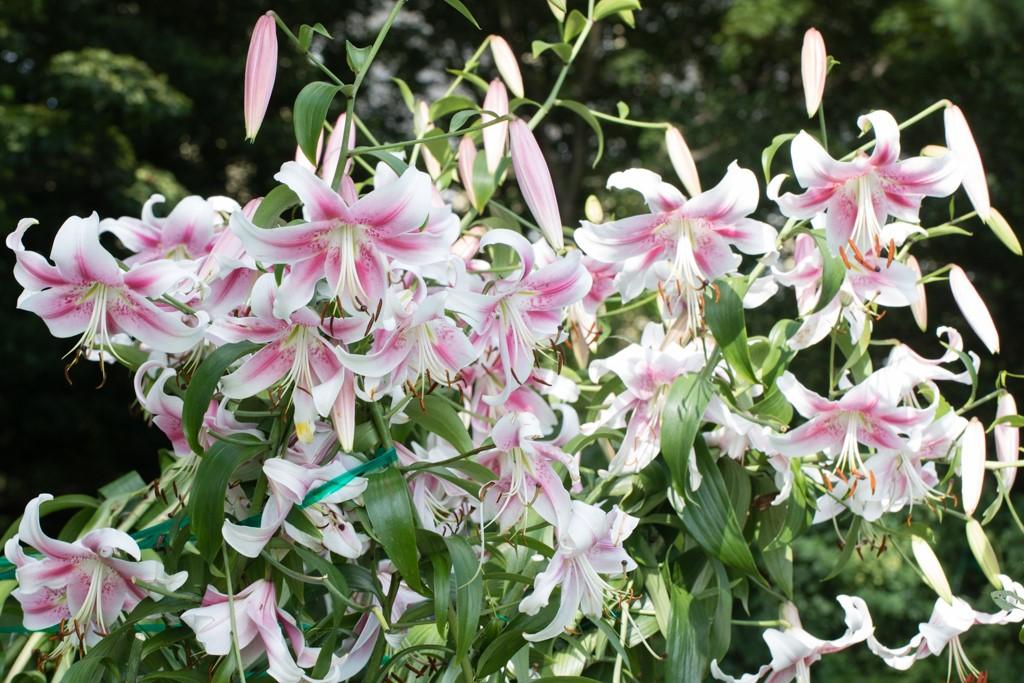Content
The lily tree is a joke among experienced gardeners. The plant is not a tree by nature, it is an ordinary flower, only very tall. Therefore, people call the lily tree-like, but the scientific name is: “oriental X tubular lilies.” Of course, it is used mainly by botanists.
What does a tree lily look like?
A tall plant can exceed 2.5 m. Perennial bushes have a powerful root system and stems to hold flowers. Tree-type lily shoots always point upward. Their diameter can range from 3 to 6 cm. At the tips there are green leaves shaped like a heart. The venation is pronounced and resembles a net in structure.
Budding occurs in early July. Then pink, yellow, white or orange flowers are formed on the giant lily tree. Some hybrids may have green buds, which is rare.

Up to 40 buds are formed on one bush; as a rule, they are located in the upper part of the crop
Most tree lilies are not uniform in color. Their petals are dotted with speckles and large patterns; sometimes the flowers have a “calm” palette - with a smooth contrasting transition. From the side, lilies look like lowered gramophones, but the shape of the bud can be tubular, cup-shaped, or goblet-shaped.
Tree lily varieties with photos and names
There are many varieties of tree lilies suitable for cultivation in the Moscow region and the middle zone. Most Popular:
- Pretty Woman. The variety grows above 2.4 m, has strong stems that do not require support. Initially, the flowers have a cream color, which becomes lighter over time. The tree-type lily exudes a sweet scent.
Pretty Woman is a variety that grows in almost any conditions
- Purple Prince. It is a giant lily, reaching more than 2 m in height. Burgundy petals are pleasant to the touch and emit a light aroma. The plant was bred by Canadian breeders; it is winter-hardy and unpretentious in care.
Experts recommend purchasing Dutch lilies of this type - this is an improved version of Purple Prince
- Anastasia. A variety with large 30-cm flowers, snow-white around the edges and bright crimson in the middle. The shape of the bud is cup-shaped, directed downwards. The inclusions on the petals are clearly visible.
In the evening, the tree-like lily exudes the scent of tropical fruits
- Scheherazade. A plant with decorative buds that rise 250 cm from the ground.The flowers are characterized by the shade of young cherry, with greenish stamens located in the central part. The petals are dotted with small patterns.
This variety is a late bloomer, the period occurs at the end of summer.
Planting a tree lily
Massive bushes are characterized by high growth rates, which makes planting as easy and accessible as possible for novice gardeners. Basically, tree-like lilies have the same habitat and growing conditions.
Landing dates
The optimal time for planting is mid-spring. During this period, the plant will quickly go through the growing season, take strong roots and form leaves in a few weeks.
Tree varieties can be planted in September. In this case, the plant will have less time to adapt, but it will undergo stratification and will be more winter-hardy later.
Site selection
Tree-type lilies can be observed in the wild. They usually grow in open areas, covered on one side by trees. The recommended daylight hours are 6-8 hours. The culture loves warm or temperate climates.
The influence of drafts must be reduced, or even better, prevented altogether. To do this, it is better to grow a tree lily along a gazebo or fence.
Despite their great love for moisture, tree lilies should not be placed in lowlands. Due to the accumulation of rainwater, the plantings will simply be washed away.The proximity of groundwater also poses a danger to plants, especially to the root system, which, with prolonged contact with water, will begin to decompose and become moldy.
Soil preparation
30 days before planting, the soil is dug up and mixed with wood ash and compost. In order for the substances to be absorbed faster, it is necessary to water the area abundantly. Organic feeding will be enough for a quick start.
Landing
When planting, they try to create optimal conditions for the growth of the tree lily.

Experienced gardeners say that the bulbs need to be cleared of dry scales - this is done to make it easier for the sprouts to hatch
After this, you need to dig a hole in the place where the fertilizer was placed. If you plan to plant several tree lilies, step 20 cm away from each hole. In the future, the plants need to be replanted. When planting directly in a permanent area, maintain a distance of at least 100 cm between the bulbs.
Pebbles, gravel, and sand are placed in the dug holes. Then the tree lily is covered with soil and watered.
Tree lily care
A young plant needs supervision. The complex of agrotechnical measures is discussed below.
Watering and fertilizing
The tree lily is moistened 2-4 times a month, depending on the weather and general soil moisture. Stimulants can be added to the water. For proper development, fertilizing is used: applied seasonally, starting with mineral supplements and gradually moving to organic matter.

By the end of autumn, only potassium and phosphorus are used
Mulching
Growing and caring for tree lilies involves mulching. The procedure is especially important in the southern regions. Mulch is necessary to reduce the amount of moisture, it also serves as a barrier against weeds.
Trimming
Tree lilies are cut back every fall. Botanists recommend cutting bushes to 10-20 cm. You cannot cut them at the root.
Wintering
Young bushes do not have the frost resistance inherent in adult lilies. Therefore, they are covered with polyethylene for the winter. In the second year, you don’t have to protect the plantings, but closer to winter, water-recharging irrigation is carried out, after which they are mulched with spruce branches.
Reproduction
Common lilies can be cultivated using bulbs, puppies, seeds and cuttings. As for tree-like plants, propagation by bulbs is especially popular.
Bushes that are about four years old are formed by children. The disadvantage of this method is that you have to wait for full flowering, which is only possible in mature plants.

However, the tree-type lily produces many bulbs.
Many varieties can be grown by seedlings. Seeds are collected in the fall, before the onset of frost. The box is cut off along with a piece of shoot and sent to ripen indoors. The material quickly loses its viability, so sowing should be done as quickly as possible.
Diseases and pests
Hybrids of tree lilies have a very strong immune system, so tree lilies get sick less often than garden varieties. Diseases include: rust, root rot, botrytis, blue mold.
The most dangerous diseases are viruses.These include mosaic and variegation. It is impossible to save a lily from viruses - all that remains is to throw it away.
The main pests are insects: beetles, aphids, weevils, spider mites. They can be dealt with using folk or chemical means. It’s even better to stick to preventative treatments so that the tree lily is not affected at all. Many insects are carriers of diseases.
Application in landscape design

The plant looks great in open meadows - as a solitary planting

Different varieties are placed at a distance from each other so that plantings do not compete

The crop is often grown in public parks, near schools

Tall plants look organic against the background of brickwork, even if it has become worn out
Conclusion
The first lily tree was grown in Canada. The variety had much in common with classic garden varieties and, at the same time, was very tall - like a shrub or a dwarf tree. Its unpretentiousness and large flowers have caused the plant to spread throughout the globe.
Reviews of tree lily












